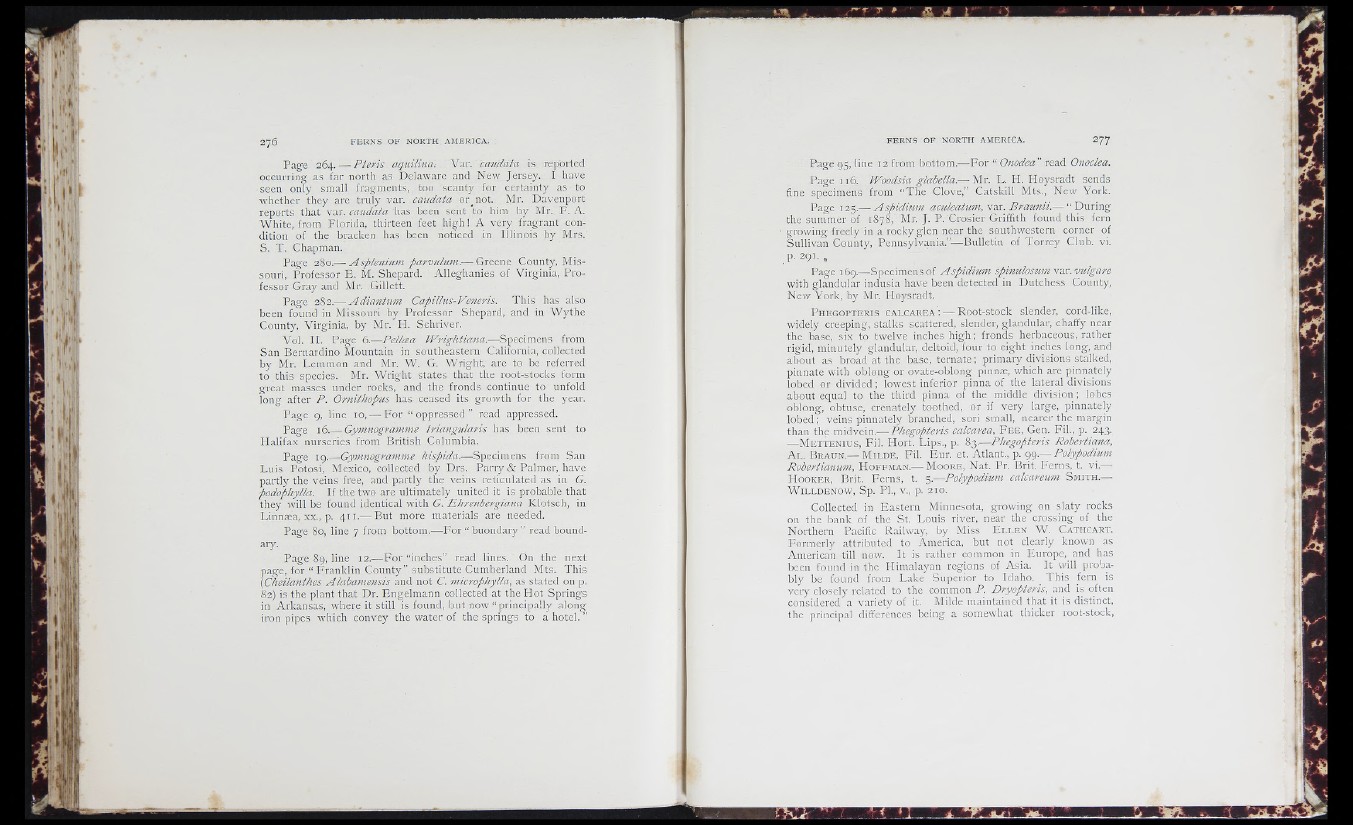
I i ]
F E R N S OF NORTH AM E R IC A .
Page 264. — Pteris aqziilina. Var. caudata is reported
occurring as far north as Delaware and New Jersey. I have
seen only small fragments, too scanty for certainty as to
whether they are truly var. ctmdata oiqnot. Mr. Davenport
reports that var. caudata has been sent *to him by Mr. F. A.
White, from Florida, thirteen feet high! A very fragrant condition
of the bracken has been noticed in Illinois by Mrs.
S. T. Chapman.
Page 280.— Asplenium parvidum.— Greene County, Missouri,
Professor E . M. Shepard. Alleghanies of Virginia, Professor
Gray and Mr. Gillett.
Page Adiantum Capillus-Veneris. This has also
been found in Missouri by Professor Shepard, and in Wythe
County, Virginia, by Mr. H. Schriver.
Vol. II. Page 6.—Pellæa PVrightiana.—Specimens from
San Bernardino Mountain in southeastern California, collected
by Mr. Lemmon and Mr. W. G. Wright, are to be referred
to this species. Mr. Wright states that the root-stocks form
great masses under rocks, and the fronds continue to unfold
long after P. Ornithopus has- ceased its growth for the year.
Page 9, line 10, — For “ oppressed” read appressed.
Page 16.— Gymnogramme friangidaris has been sent to
Flalifax nurseries from British Columbia.
Page 19.—Gymnogramme hispida.—Specimens from San
Luis Potosi, Mexico, collected by Drs. Parry & Palmer, have
partly the veins free, and partly the veins reticulated as in G.
podophylla. I f the two are ultimately united it is probable that
they will be found identical with G. Ehrenbergiana Klotsch, in
Linniea, XX., p. 4 1 1.— But more materials are needed.
Page 80, line 7 from bottom.— For “ buondary ” read boundary.
Page 89, line 1 2 .- -For “inches” read lines. On the next
page, for “ Franklin County” substitute Cumberland Mts. This
{Cheilanthes Alabamensis and not C. microphylla, as stated on p.
82) is the plant that Dr. Engelmann collected at the Hot Springs
in Arkansas, where it still is found, hut now “ principally along
iron pipes which convey the water of the springs to a hotel. ”
F E R N S OF NORTH AM E R IC A . 277
Page 95, line 12 from bottom.— For “ Onodea" read Onoclea.
Page 116. Woodsia glabella.— Mr. L. H. Hoysradt sends
fine specimens from “ The Clove,” Catskill Mts., New York.
Page 125.— Aspidium aczdeatum, var. Braunii.— “ During
the summer of 1878, Mr. J. P. Crosier Griffith found this fern
growing freely in a rocky glen near the southwestern corner of
Sullivan County, Pennsylvania.”— Bulletin of Torrey Club. vi.
p. 291.
Page 169.— Specimens of Aspidium spimdosum var. vidgare
with glandular indusia have been detected in Dutchess County,
New York, by Mr. Hoysradt.
P h e g o p t e r i s C A L C A R E A '; — Root-stock slender, cord-like,
widely creeping, stalks scattered, slender, glandular, chaffy near
the base, six to twelve inches high; fronds herbaceous, rather
rigid, minutely glandular, deltoid, four to eight inches long, and
about as broad at the base, ternate ; primary divisions stalked,
pmnate with oblong or ovate-oblong pinnæ, which are pinnately
lobed or divided ; lowest inferior pinna of the lateral divisions
about equal to the third pinna of the middle division ; lobes
oblong, obtuse, crenately toothed, or if very large, pinnately
lobed; veins pinnately branched, sori small, nearer the margin
than the midvein.— Phegopteris calcarea, F e e , Gen. Fil., p. 243.
—M e t t e n i u s , Fil. Hort. Lips., p. 83.— Phegopteris Robertiana,
A l . B r a u n .— M i l d e , Fil. Fur. et. Atlant., p. 99.— Polypodium
Robertiammi, F I o f f m a n .— M o o r e , Nat. Pr. Brit. Ferns, t. vi.—
I-IooKER, Brit. Ferns, t. 5.— Polypodium calcareum S m i t h .—■
W i l l d e n o w , Sp. Pl., v., p. 210.
Collected in Eastern Minnesota, growing on slaty rocks
on the bank of the St. Louis river, near the crossing of the
Northern Pacific Railway, by Miss E l l e n W. C a t h c a r t .
Formerly attributed to America, but not clearly known as
American till now. It is rather common in Europe, and has
been found in the Himalayan regions of Asia. It will probably
be found from Lake Superior to Idaho. This fern is
very closely related to the common P. Dryopteris, and is often
considered a variety of it. Milde maintained that it is distinct,
the principal differences being a somewhat thicker root-stock,
A i
y